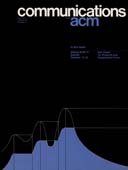July 1977 - Vol. 20 No. 7

Features
Dynamic response time prediction for computer networks
If the ultimate aim of a computing network is resource sharing, then the human component as well as the technical component of networking must be fully investigated to achieve this goal. This research is a first step toward assisting the user in participating in the vast store of resources available on a network. Analytical, simulation, and statistical performance evaluation tools are employed to investigate the feasibility of a dynamic response time monitor that is capable of providing comparative response time information for users wishing to process various computing applications at some network computing node. The research clearly reveals that sufficient system data are currently obtainable, at least for the five diverse ARPA network systems studied in detail, to describe and predict the response time for network time-sharing systems as it depends on some measure of system activity or load level.
A unifying approach to scheduling
This paper presents a scheme for classifying scheduling algorithms based on an abstract model of a scheduling system which formalizes the notion of priority. Various classes of scheduling algorithms are defined and related to existing algorithms. A criterion for the implementation efficiency of an algorithm is developed and results in the definition of time-invariant algorithms, which include most of the commonly implemented ones. For time-invariant algorithms, the dependence of processing rates on priorities is derived. The abstract model provides a framework for implementing flexible schedulers in real operating systems. The policy-driven scheduler of Bernstein and Sharp is discussed as an example of
In order for the nodes of a distributed computer network to communicate, each node must have information about the network's topology. Since nodes and links sometimes crash, a scheme is needed to update this information. One of the major constraints on such a topology information scheme is that it may not involve a central controller. The Topology Information Protocol that was implemented on the MERIT Computer Network is presented and explained; this protocol is quite general and could be implemented on any computer network. It is based on Baran's “Hot Potato Heuristic Routing Doctrine.” A correctness proof of this Topology Information Protocol is also presented.
A terminal-oriented communication system
This paper describes a system for full-duplex communication between a time-shared computer and its terminals. The system consists of a communications computer directly connected to the time-shared system, a number of small remote computers to which the terminals are attached, and connecting medium speed telephone lines. It can service a large number of terminals of various types. The overall system design is presented along with the algorithms used to solve three specific problems: local echoing, error detection and correction on the telephone lines, and multiplexing of character output.
SITAR: an interactive text processing system for small computers
SITAR, a low-cost interactive text handling and text analysis system for nontechnical users, is in many ways comparable to interactive bibliographical search and retrieval systems, but has several additional features. It is implemented on a PDP/11 time-sharing computer invoked by a CRT with microprogrammed editing functions. It uses a simple command language designating a function, a file, and a search template consisting of the textual string desired and strings delimiting the context in which the hit is to be delivered. Extensive experience with SITAR shows that the combined powers of simple commands, string orientation, circular file structure, a CRT with local memory, and conversational computing produce a system much more powerful than the sum of its parts.
An alternative to event queues for synchronization in monitors
In the monitor concept, as proposed by Brinch Hansen and Hoare, event queues are used for synchronization. This paper describes another synchronizing primitive which is nearly as expressive as the conditional wait, but can be implemented more efficiently. An implementation of this primitive in terms of P and V operations is given together with a correctness proof. Two examples are presented: the readers and writers problem and the problem of information streams sharing a finite buffer pool.
Certification of programs for secure information flow
ertification mechanism for verifying the secure flow of information through a program. Because it exploits the properties of a lattice structure among security classes, the procedure is sufficiently simple that it can easily be included in the analysis phase of most existing compilers. Appropriate semantics are presented and proved correct. An important application is the confinement problem: The mechanism can prove that a program cannot cause supposedly nonconfidential results to depend on confidential input data.
Shifting garbage collection overhead to compile time
This paper discusses techniques which enable automatic storage reclamation overhead to be partially shifted to compile time. The paper assumes a transaction oriented collection scheme, as proposed by Deutsch and Bobrow, the necessary features of which are summarized. Implementing the described optimizations requires global flow analysis to be performed on the source program. It is shown that at compile time certain program actions that affect the reference counts of cells can be deduced. This information is used to find actions that cancel when the code is executed and those that can be grouped to achieve improved efficiency.
Lucid, a nonprocedural language with iteration
Lucid is a formal system in which programs can be written and proofs of programs carried out. The proofs are particularly easy to follow and straightforward to produce because the statements in a Lucid program are simply axioms from which the proof proceeds by (almost) conventional logical reasoning, with the help of a few axioms and rules of inference for the special Lucid functions. As a programming language, Lucid is unconventional because, among other things, the order of statements is irrelevant and assignment statements are equations. Nevertheless, Lucid programs need not look much different than iterative programs in a conventional structured programming language using assignment and conditional statements and loops.



